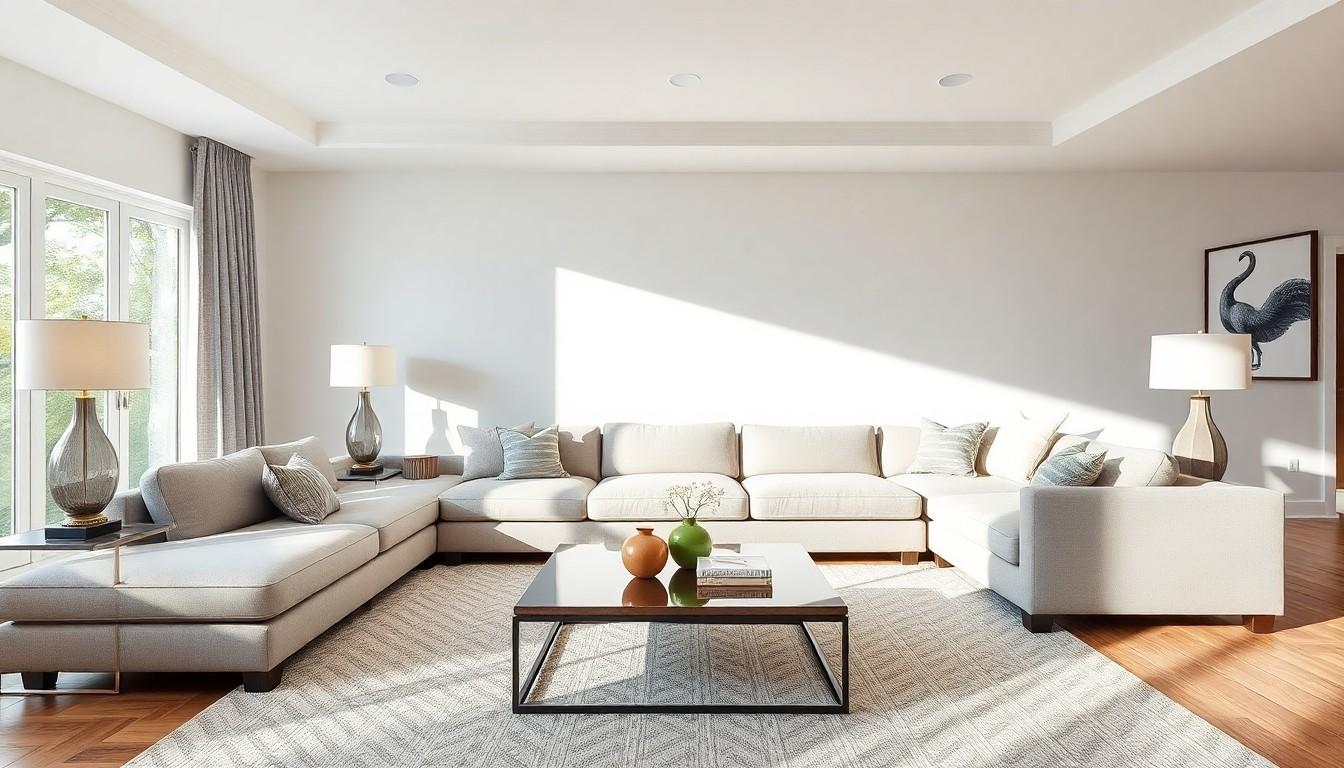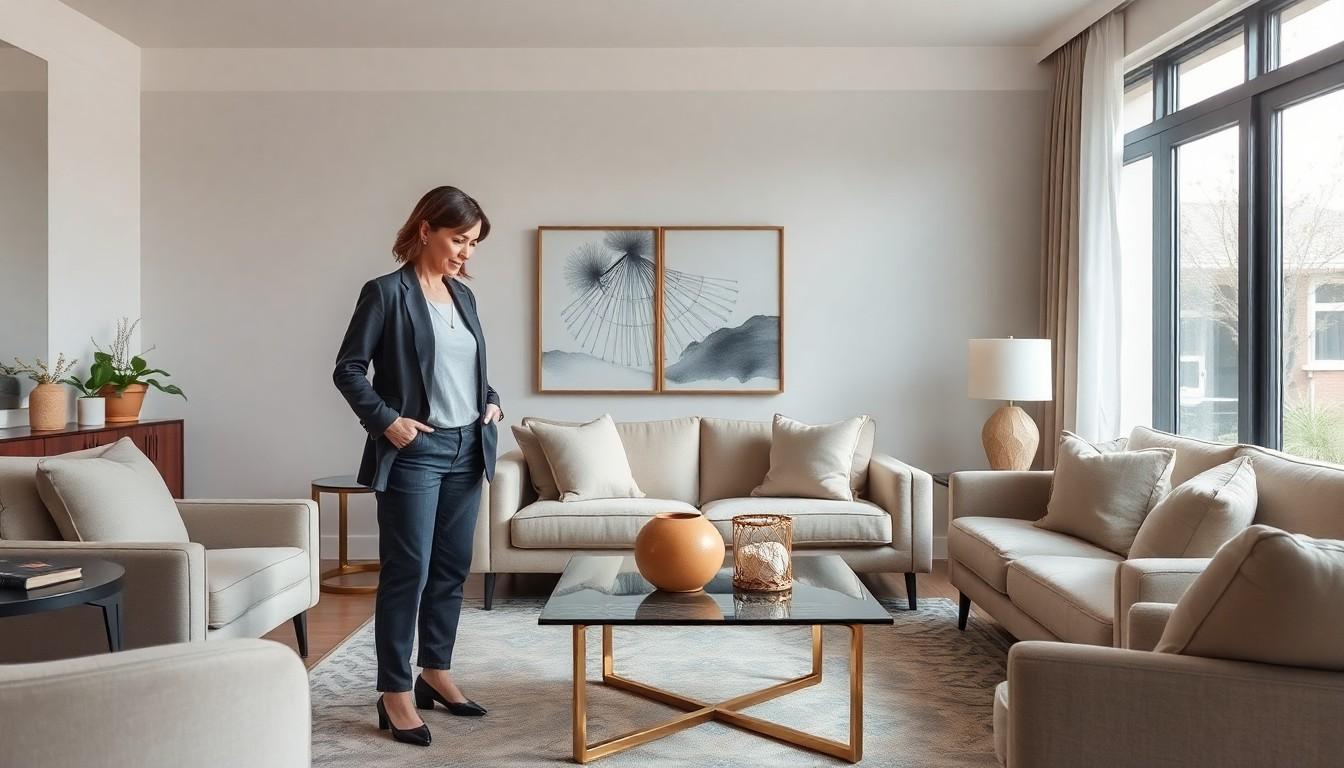In the world of interior design, proportion is the unsung hero that can make or break a space. Imagine walking into a room where the furniture looks like it was borrowed from a dollhouse—awkward, right? Proper proportion creates harmony, ensuring that each element fits together like a perfectly baked pie. It’s not just about making things look pretty; it’s about crafting an atmosphere where comfort and style coexist.
Understanding Proportion Interior Design
Proportion plays a crucial role in shaping the overall aesthetic of an interior space. Factors such as scale and relationships among various elements significantly impact how a room feels and functions.
Definition of Proportion
Proportion refers to the relative size of items in relation to one another. This concept includes the dimensions of furniture, the heights of ceilings, and the square footage of rooms. Measurements ensure that every component fits and works harmoniously. Appropriate ratios create balance, making spaces visually appealing and comfortable for occupants.
Importance of Proportion in Interior Design
Proportion enhances the functionality and beauty of interiors. When elements match in size and scale, an atmosphere of cohesion emerges. Designers focus on proportion to prevent crowded or sparse feels in spaces. Additionally, precise ratios can highlight focal points, guiding the eye naturally across a room. This emphasis leads to a pleasant living experience, combining comfort with aesthetic value.
Key Principles of Proportion Interior Design

Proportion is essential in achieving a cohesive and aesthetically pleasing interior. Understanding the key principles helps create comfortable and stylish spaces.
Scale and Size
Scale refers to the relative size of objects in a given space. Matching furniture dimensions with room size is crucial. For instance, a large sectional sofa may overwhelm a small living room. Conversely, tiny furniture pieces can look lost in expansive areas. Designers often consider human scale, ensuring that furniture heights, widths, and depths align with occupant comfort. It’s advisable to measure available space before purchasing furniture. Recognizing scale and size enhances spatial functionality, creating an inviting atmosphere.
Balance and Symmetry
Balance ensures that visual weight is distributed evenly throughout a room. Symmetry typically involves mirroring elements on either side of a focal point. For example, placing identical lamps on nightstands offers a sense of equilibrium. Asymmetrical balance, while less rigid, maintains harmony by balancing contrasting elements. An oversized chair paired with smaller side tables can achieve this effect. Both approaches foster a soothing environment, allowing occupants to feel at ease within the space. Effective balance and symmetry contribute significantly to the overall appeal of interior design.
Practical Applications of Proportion Interior Design
Understanding proportion greatly enhances interior design applications. It allows designers to create spaces that feel cohesive and functional.
Room Layout and Functionality
Effective room layouts utilize proportion to enhance functionality. Arranging furniture in relation to the room’s dimensions fosters movement and usability. For instance, a large sectional sofa might consume an entire living area, necessitating ample walking space. Conversely, smaller rooms suit compact furniture that maximizes comfort without overcrowding. Designers frequently measure distances between elements, ensuring proportionate spacing that fosters interaction. Establishing clear pathways, particularly in high-traffic areas, contributes to an overall harmonious flow within a space.
Color and Texture Considerations
Proportion also plays a vital role in color and texture selection. Choosing paint colors and fabrics requires matching their scale to room size. Lighter colors often expand perceived space, while darker hues can create a cozy atmosphere. Textures should also complement proportions; for example, plush fabrics work well in larger rooms, whereas sleek surfaces suit smaller spaces. Incorporating contrasting textures can enhance depth, providing visual interest without overwhelming the area. Striking a balance between palette and material ensures every element contributes to the room’s overall harmony.
Challenges in Proportion Interior Design
Proportion challenges arise frequently in interior design. Designers might struggle with furniture size, scale, and spatial relationships, leading to discomfort and unbalanced spaces.
Common Mistakes
Choosing furniture items without considering their relation to room dimensions ranks as a significant mistake. Underestimating the importance of human scale often results in pieces that overwhelm or diminish the intended aesthetic. Ignoring visual weight distribution creates areas that feel crowded or too sparse. Failure to incorporate varying heights causes a lack of dynamism in a layout. Misjudging the balance of texture within a room leads to inconsistent atmospheres that disrupt cohesion.
Solutions and Tips
Measuring room dimensions accurately serves as a fundamental step before purchasing any furniture. Selecting pieces that complement each other in size and shape contributes to a harmonious environment. Incorporating layers of texture, from fabrics to surfaces, enhances visual interest while maintaining unity. Developing a focal point encourages organized attention within the space. Considering the balance of colors can also elevate the overall atmosphere, ensuring an appealing aesthetic across all elements.
Conclusion
Understanding proportion in interior design is essential for creating spaces that feel both inviting and stylish. By carefully considering the relationships between furniture dimensions and room size, designers can foster a sense of balance and harmony. Achieving the right scale enhances functionality and aesthetics, ensuring that each element contributes positively to the overall environment.
Attention to detail in layout, color, and texture further elevates the design experience. With a thoughtful approach to proportion, anyone can transform their space into a cohesive sanctuary that reflects personal style while promoting comfort. Embracing these principles not only enhances visual appeal but also enriches daily living experiences.





